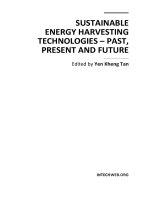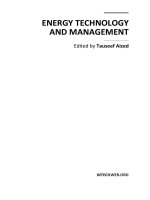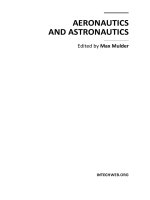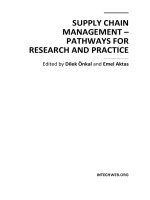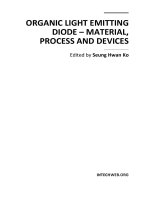Lubricants and Lubrication Part 1 pot
Bạn đang xem bản rút gọn của tài liệu. Xem và tải ngay bản đầy đủ của tài liệu tại đây (482.43 KB, 60 trang )
Lubricants and Lubrication
Edited by Theo Mang and Wilfried Dresel
Lubricants and Lubrication. 2nd Ed. Edited by Th. Mang and W. Dresel
Copyright 2007 WILEY-VCH Verlag GmbH & Co. KGaA, Weinheim
ISBN: 978-3-527-31497-3
Each generation has its unique needs and aspirations. When Charles Wiley first
opened his small printing shop in lower Manhattan in 1807, it was a generation
of boundless potential searching for an identity. And we were there, helping to
define a new American literary tradition. Over half a century later, in the midst
of the Second Industrial Revolution, it was a generation focused on building
the future. Once again, we were there, supplying the critical scientific, technical,
and engineering knowledge that helped frame the world. Throughout the 20th
Century, and into the new millennium, nations began to reach out beyond their
own borders and a new international community was born. Wiley was there, ex-
panding its operations around the world to enable a global exchange of ideas,
opinions, and know-how.
For 200 years, Wiley has been an integral part of each generation s journey,
enabling the flow of information and understanding necessary to meet their
needs and fulfill their aspirations. Today, bold new technologies are changing
the way we live and learn. Wiley will be there, providing you the must-have
knowledge you need to imagine new worlds, new possibilities, and new oppor-
tunities.
Generations come and go, but you can always count on Wiley to provide you
the knowledge you need, when and where you need it!
William J. Pesce Peter Booth Wiley
President and Chief Executive Officer Chairman of the Board
1807–2007 Knowledge for Generations
Lubricants and Lubrication
Edited by
Theo Mang and Wilfried Dresel
Second, Completely Revised and Extended Edition
Editors
Prof. Dr. Theo Mang
Holzweg 30
69469 Weinheim
Germany
Dr. Wilfried Dresel
Treppenweg 4
67063 Ludwigshafen
Germany
1. Edition 2001
2. Edition 2007
&
All books published by Wiley-VCH are
carefully produced. Nevertheless, authors,
editors, and publisher do not warrant the
information contained in these books,
including this book, to be free of errors.
Readers are advised to keep in mind that
statements, data, illustrations, procedural
details or other items may inadvertently be
inaccurate.
Library of Congress Card No.:
applied for
British Library Cataloguing-in-Publication Data
A catalogue record for this book is
available from the British Library.
Bibliographic information published by the
Deutsche Nationalbibliothek
The Deutsche Nationalbibliothek lists this
publication in the Deutsche National-
bibliografie; detailed bibliographic data are
available in the Internet at
.
2007 WILEY-VCH GmbH, Weinheim
All rights reserved (including those of
translation into other languages). No part of
this book may be reproduced in any form –
by photoprinting, m icrofilm, or any other
means – nor transmitted or translated into a
machine language without written permis-
sion from the publishers. Registered names,
trademarks, etc. used in this book, even
when not specifically marked as such, are
not to be considered unprotected by law.
Composition Kühn & Weyh, Freiburg
Printing betz-druck GmbH, Darmstadt
Bookbinding Litges & Dopf Buchbinderei
GmbH, Heppenheim
Printed in the Federal Republic of Germany
Printed on acid-free paper
ISBN 978-3-527-31497-3
V
List of Contributors
Thorsten Bartels
Dr Ing., Weisenheim am Sand , Germany
Technical Service Management and Test Lab
Management
Wolfgang Bock
Dipl Ing., Weinheim, Germany
International Product Management Industrial Oils
Jürgen Braun
Dr. rer. nat., Speyer, Germany
R&D for Industrial Oils
Christian Busch
Dr Ing., Kaiserslautern, Germany
Managing Director
Wolfgang Buss
Dr. rer. nat., Freinsheim, Germany
R&D and Product Management for Forming
Lubricants
Wilfried Dresel
Dr. rer. nat., Ludwigshafen, Germany
R&D for Lubricating Greases (International)
Carmen Freiler
Dipl Ing., Hüttenfeld, Germany
R&D and Product Management for Metal Cutting
Fluids
Manfred Harperscheid
Dr. rer. nat., Römerberg, Germany
R&D for Engine Oils
Rolf-Peter Heckler
Dipl Ing., Neu-Isenburg, Germany
International Product Management for
Lubricating Greases
Dietrich Hörner
Dr. rer. nat., Hassloch, Germany
International Product Management for
Metalworking Fluids and Quenching Oils
Franz Kubicki
Dipl Ing., Hockenheim, Germany
International Product Management for Corrosion
Preventives and Sheet Metalforming
Georg Lingg
Dr Ing., Mannheim, Germany
Member of the Executive Board, Technology and
Supply Chain
Achim Losch
Dr. rer. nat., Westhofen, Germany
R&D for Corrosion Preventives, Metalforming and
Cleaners
Rolf Luther
Dipl Phys., Speyer, Germany
Head of Test Fields and Advanced Development
Theo Mang
Prof. Dr Ing., Weinheim, Germany
Group’s Executive Board, Technology, Group
Purchasing, Human Resources (until 2001)
Roman Müller
Mannheim, Germany
International Know-How Transfer
Siegfried Noll
Chemist, Mannheim, Germany
Raw Material Specifications, Central Purchasing
and General Management († 2003)
Jürgen Omeis
Dr. rer. nat., Zwingenberg, Germany
R&D for Engine Oils (until 2004)
Lubricants and Lubrication. 2nd Ed. Edited by Th. Mang and W. Dresel
Copyright 2007 WILEY-VCH Verlag GmbH & Co. KGaA, Weinheim
ISBN: 978-3-527-31497-3
VII
List of Contributors V
Preface, Foreword 2nd edition XXXIII
A Word of Thanks XXXV
List of Abbreviations XXXVII
1 Lubricants and their Market 1
Theo Mang
1.1 Preface 1
1.2 Lubricant Sales 2
1.3 The Lubricants Industry 3
1.4 Lubricant Systems 5
2 Lubricants in the Tribological System 7
Theo Mang
2.1 Lubricants as Part of Tribological Research 7
2.2 The Tribological System 8
2.3 Friction 8
2.3.1 Types of Friction 9
2.3.1.1 Sliding Friction 9
2.3.1.2 Rolling Friction 10
2.3.1.3 Static Friction 10
2.3.1.4 Kinetic Friction 10
2.3.1.5 Stick–Slip 10
2.3.2 Friction and Lubrication Conditions 12
2.3.2.1 Solid Friction (Dry Friction) 12
2.3.2.2 Boundary Friction 12
2.3.2.3 Fluid Friction 13
2.3.2.4 Mixed Friction 13
2.3.2.5 Solid Lubricant Friction 13
Contents
Lubricants and Lubrication. 2nd Ed. Edited by Th. Mang and W. Dresel
Copyright 2007 WILEY-VCH Verlag GmbH & Co. KGaA, Weinheim
ISBN: 978-3-527-31497-3
VIII Contents
2.3.2.6 Stribeck Diagram 14
2.3.2.7 Hydrodynamic Lubrication 14
2.3.2.8 Elasto–Hydrodynamic Lubrication (EHD Regime) 15
2.3.2.9 Thermo-elasto-hydrodynamic Lubrication (TEHD) 15
2.4 Wear 17
2.4.1 Wear Mechanisms 17
2.4.1.1 Abrasion 17
2.4.1.2 Adhesion 17
2.4.1.3 Tribochemical Reactions 17
2.4.1.4 Surface Fatigue 17
2.4.1.5 Erosion 18
2.4.1.6 Fretting 18
2.4.1.7 Cavitation 18
2.4.2 Types of Wear 18
2.4.3 The Wear Process 18
2.4.4 Tribomutation 19
2.4.5 Nanotribology 20
2.4.6 Tribosystems of Tomorrow 22
3 Rheology of Lubricants 23
Theo Mang
3.1 Viscosity 23
3.2 Influence of Temperature on Viscosity (V–T Behavior) 25
3.2.1 Viscosity Index 26
3.3 Viscosity–Pressure Dependency 27
3.4 The Effect of Shear Rate on Viscosity 28
3.5 Special Rheological Effects 30
3.5.1 Greases 31
3.6 Viscosity Grades 31
3.6.1 ISO Viscosity Grades 32
3.6.2 Other Viscosity Grades 32
3.6.2.1 Engine Oils 32
3.6.2.2 Automotive Gear Oils 32
3.6.2.3 Industrial Gear Oils 32
3.6.2.4 Viscosity Grades for Base Oils 33
3.6.2.5 Comparison of Viscosity Grades 33
4 Base Oils 34
Theo Mang and Georg Lingg
4.1 Base Oils– A Historical Review and Outlook 34
4.2 Chemical Characterization of Mineral Base Oils 35
4.2.1 Rough Chemical Characterization 35
4.2.1.1 Viscosity–Gravity Constant (VGC) 35
4.2.1.2 Aniline Point 35
IXContents
4.2.2 Carbon Distribution 36
4.2.3 Hydrocarbon Composition 36
4.2.4 Polycyclic Aromatics in Base Oils 36
4.2.4.1 Aromatics in White Mineral Oils 37
4.3 Refining 38
4.3.1 Distillation 39
4.3.2 De-asphalting 39
4.3.3 Traditional Refining Processes 40
4.3.3.1 Acid Refining 41
4.3.3.2 Solvent Extraction 41
4.3.4 Solvent Dewaxing 43
4.3.5 Finishing 44
4.3.5.1 Lube Crudes 44
4.4 Base Oil Manufacturing by Hydrogenation and Hydrocracking 45
4.4.1 Manufacturing Naphthenic Base Oils by Hydrogenation 46
4.4.2 Production of White Oils 48
4.4.3 Lube Hydrocracking 49
4.4.4 Catalytic Dewaxing 50
4.4.5 Wax Isomerization 52
4.4.6 Hybrid Lube Oil Processing 52
4.4.7 All-Hydrogen Route 53
4.4.8 Gas-to-Liquids Conversion Technology 55
4.5 Boiling and Evaporation Behavior of Base Oils 55
4.6 Base Oil Categories and Evaluation of Various Petroleum Base Oils 59
5 Synthetic Base Oils 63
Wilfried Dresel
5.1 Synthetic Hydrocarbons 64
5.1.1 Polyalphaolefins 65
5.1.2 Polyinternalolefins 67
5.1.3 Polybutenes 68
5.1.4 Alkylated Aromatics 69
5.1.5 Other Hydrocarbons 70
5.2 Halogenated Hydrocarbons 71
5.3 Synthetic Esters 71
5.3.1 Esters of carboxylic acids 71
5.3.1.1 Dicarboxylic Acid Esters 72
5.3.1.2 Polyol Esters 73
5.3.1.3 Other Carboxylic Esters 74
5.3.1.4 Complex Esters 75
5.3.1.5 Fluorinated Carboxylic Acid Esters 76
5.3.2 Phosphate Esters 76
5.4 Polyalkylene Glycols 77
5.5 Other Polyethers 79
X Contents
5.5.1 Perfluorinated Polyethers 79
5.5.2 Polyphenyl Ethers 80
5.5.3 Polysiloxanes (Silicone Oils) 81
5.6 Other Synthetic Base Oils 83
5.7 Comparison of Synthetic Base Oils 87
5.8 Mixtures of Synthetic Lubricants 87
6 Additives 88
Jürgen Braun
6.1 Antioxidants 89
6.1.1 Mechanism of Oxidation and Antioxidants 89
6.1.2 Compounds 91
6.1.2.1 Phenolic Antioxidants 91
6.1.2.2 Aromatic Amines 91
6.1.2.3 Compounds Containing Sulfur and Phosphorus 92
6.1.2.4 Organosulfur Compounds 92
6.1.2.5 Organophosphorus Compounds 93
6.1.2.6 Other Compounds 93
6.1.2.7 Synergistic Mixtures 93
6.1.3 Testing of the Oxidation Stability 93
6.2 Viscosity Modifiers 94
6.2.1 Physical Description of Viscosity Index 94
6.2.2 VI Improvement Mechanisms 94
6.2.3 Structure and Chemistry of Viscosity Modifiers 96
6.3 Pourpoint Depressants (PPD) 97
6.4 Detergents and Dispersants 99
6.4.1 Mechanism of DD Additives 100
6.4.2 Metal-containing Compounds (Detergents) 100
6.4.2.1 Phenates 100
6.4.2.2 Salicylates 100
6.4.2.3 Thiophosphonates 101
6.4.2.4 Sulfonates 102
6.4.3 Ashless Dispersants (AD) 103
6.5 Antifoam Agents 105
6.5.1 Silicon Defoamers 105
6.5.2 Silicone-free Defoamers 106
6.6 Demulsifiers and Emulsifiers 106
6.6.1 Demulsifiers 106
6.6.2 Emulsifiers 106
6.7 Dyes 107
6.8 Antiwear (AW) and Extreme Pressure (EP) Additives 107
6.8.1 Function of AW/EP Additives 107
6.8.2 Compounds 108
6.8.2.1 Phosphorus Compounds 108
XIContents
6.8.2.2 Compounds Containing Sulfur and Phosphorus 109
6.8.2.3 Compounds Containing Sulfur and Nitrogen 110
6.8.2.4 Sulfur Compounds 111
6.8.2.5 PEP Additives 112
6.8.2.6 Chlorine Compounds 112
6.8.2.7 Solid Lubricating Compounds 113
6.9 Friction Modifiers (FM) 113
6.10 Corrosion Inhibitors 114
6.10.1 Mechanism of Corrosion Inhibitors 114
6.10.2 Antirust Additives (Ferrous Metals) 115
6.10.2.1 Sulfonates 115
6.10.2.2 Carboxylic Acid Derivatives 115
6.10.2.3 Amine Neutralized Alkylphosphoric Acid Partial Esters 116
6.10.2.4 Vapor Phase Corrosion Inhibitors 116
6.10.3 Metal Passivators (Non-ferrous Metals) 117
7 Lubricants in the Environment 119
Rolf Luther
7.1 Definition of Environmentally Friendly Lubricants’ 119
7.2 Current Situation 120
7.2.1 Statistical Data 120
7.2.2 Economic Consequences and Substitution Potential 121
7.2.3 Agriculture, Economy, and Politics 123
7.2.4 Political Initiatives 124
7.3 Tests to Evaluate Biotic Potential 125
7.3.1 Biodegradation 125
7.3.2 Ecotoxicity 126
7.3.3 Emission Thresholds 127
7.3.4 Water Pollution 127
7.3.4.1 The German Water Hazardous Classes 127
7.3.4.2 German Regulations for Using Water-endangering Lubricants
(VAwS)
128
7.4 Environmental Legislation 1:
Registration, Evaluation and Authorization of Chemicals (REACh)
130
7.4.1 Registration 132
7.4.2 Evaluation 132
7.4.2 Authorization 133
7.4.2 Registration Obligations 135
7.5 Globally Harmonized System of Classification and Labeling (GHS) 136
7.6 Environmental Legislation 2: Dangerous Preparations Directive
(1999/45/EC)
139
7.7 Environmental Legislation 3: Regular use 140
7.7.1 Environmental Liability Law 141
7.7.2 The Chemicals Law, Hazardous Substances Law 141
XII Contents
7.7.3 Transport Regulations 142
7.7.4 Disposal (Waste and Recycling Laws) 142
7.7.5 Disposal Options for Not water pollutant’ Vegetable Oils 143
7.8 Environmental Legislation 4: Emissions 144
7.8.1 Air Pollution 144
7.8.2 Water Pollution 144
7.8.3 German Law for Soil Protection 145
7.8.4 German Water Law 146
7.8.5 Waste Water Charges 147
7.8.6 Clean Air: German Emissions Law 147
7.8.7 Drinking Water Directive 147
7.9 Standardization of Environmentally Compatible Hydraulic Fluids 148
7.9.1 The German Regulation VDMA 24568 148
7.9.2 ISO Regulation 15380 148
7.10 Environmental Seal 153
7.10.1 Global Eco-labeling Network 153
7.10.2 European Eco-label 153
7.10.3 The German Blue Angel’ 157
7.10.4 Nordic countries (Norway, Sweden, Finland, Iceland)–White
Swan’
158
7.10.4.1 Requirements Concerning Renewable Resources 160
7.10.4.2 Requirements Concerning Re-refined Oil 160
7.10.4.3 Requirements Concerning Environmentally Harmful Components 160
7.10.4.4 Requirements for Hydraulic Fluids, Mould Oil, Metalworking
Fluids
160
7.10.5 The Canadian Environmental Choice’ (Maple Leaf) 160
7.10.6 Other Eco-labels 162
7.10.6.1 Austria 162
7.10.6.2 France 162
7.10.6.3 Japan 163
7.10.6.4 USA 163
7.10.6.5 The Netherlands 163
7.11 Base Fluids 164
7.11.1 Biodegradable Base Oils for Lubricants 164
7.11.2 Synthetic Esters 165
7.11.3 Polyglycols 166
7.11.4 Polyalphaolefins 166
7.11.5 Relevant Properties of Ester Oils 166
7.11.5.1 Evaporation Loss 166
7.11.5.2 Viscosity–Temperature Behavior 166
7.11.5.3 Boundary Lubrication 167
7.12 Additives 167
7.12.1 Extreme Pressure/Antiwear Additives 167
7.12.2 Corrosion Protection 168
7.12.3 Antioxidants 168
XIIIContents
7.13 Products (Examples) 168
7.13.1 Hydraulic Fluids 169
7.13.2 Metal Working Oil 169
7.13.3 Oil-refreshing System 170
7.14 Safety Aspects of Handling Lubricants (Working Materials) 171
7.14.1 Toxicological Terminology and Hazard Indicators 171
7.14.1.1 Acute Toxicity 171
7.14.1.2 Subchronic and Chronic Toxicity 172
7.14.1.3 Poison Categories 172
7.14.1.4 Corrosive, Caustic 172
7.14.1.5 Explosion and Flammability 172
7.14.1.6 Carcinogenic 173
7.14.1.7 Teratogens, Mutagens 173
7.14.2 MAK (Maximum Workplace Concentration) Values 173
7.14.3 Polycyclic Aromatic Hydrocarbons (PAK, PAH, PCA) 174
7.14.4 Nitrosamines in Cutting Fluids 174
7.14.5 Law on Flammable Fluids 175
7.15 Skin Problems Caused by Lubricants 176
7.15.1 Structure and Function of the Skin 176
7.15.2 Skin Damage 177
7.15.2.1 Oil Acne (Particle Acne) 177
7.15.2.2 Oil Eczema 178
7.15.3 Testing Skin Compatibility 179
7.15.4 Skin Function Tests 180
7.15.5 Skin Care and Skin Protection 182
8 Disposal of Used Lubricating Oils 183
Theo Mang
8.1 Possible Uses of Waste Oil 184
8.2 Legislative Influences on Waste Oil Collection and Reconditioning 184
8.3 Re-refining 185
8.3.1 Sulfuric Acid Refining (Meinken) 185
8.3.2 Propane Extraction Process (IFP, Snamprogetti) 186
8.3.3 Mohawk Technology (CEP–Mohawk) 187
8.3.4 KTI Process 187
8.3.5 PROP Process 187
8.3.6 Safety Kleen Process 188
8.3.7 DEA Technology 189
8.3.8 Other Re-refining Technologies 190
9 Lubricants for Internal Combustion Engines 191
Manfred Harperscheid and Jürgen Omeis
9.1 Four-stroke Engine Oils 191
9.1.1 General Overview 191
XIV Contents
9.1.1.1 Fundamental Principles 192
9.1.1.2 Viscosity Grades 193
9.1.1.3 Performance Specifications 195
9.1.1.4 Formulation of Engine Oils 196
9.1.1.5 Additives 196
9.1.1.6 Performance Additives 196
9.1.1.7 Viscosity Improvers 197
9.1.2 Characterization and Testing 197
9.1.2.1 Physical and Chemical Testing 198
9.1.2.2 Engine Testing 198
9.1.2.3 Passenger Car Engine Oils 200
9.1.2.4 Engine Oil for Commercial Vehicles 201
9.1.3 Classification by Specification 202
9.1.3.1 MIL Specifications 202
9.1.3.2 API and ILSAC Classification 203
9.1.3.3 CCMC Specifications 205
9.1.3.4 ACEA Specifications 206
9.1.3.5 Manufacturers’ Approval of Service Engine Oils 209
9.1.3.6 Future Trends 214
9.1.3.7 Fuel Efficiency 214
9.1.3.8 Long Drain Intervals 216
9.1.3.9 Low Emission 217
9.2 Two-stroke Oils 218
9.2.1 Application and Characteristics of Two-stroke Oils 218
9.2.2 Classification of Two-stroke Oils 220
9.2.2.1 API Service Groups 220
9.2.2.2 JASO Classification 220
9.2.2.3 ISO Classification 221
9.2.3 Oils for Two-stroke Outboard Engines 222
9.2.4 Environmentally Friendly Two-stroke Oils 223
9.3 Tractor Oils 224
9.4 Gas Engine Oils 225
9.4.1 Use of Gas Engines –Gas as a Fuel 226
9.4.2 Lubricants for Gas Engines 226
9.5 Marine Diesel Engine Oils 227
9.5.1 Low-speed Crosshead Engines 227
9.5.2 Medium-speed Engines 228
9.5.3 Lubricants 229
10 Gear Lubrication Oils 230
Thorsten Bartels
10.1 Introduction 230
10.2 Requirements of Gear Lubrication Oils 231
10.3 Tribology of Gears 233
XVContents
10.3.1 Friction Conditions of Gear Types 234
10.3.1.1 Toothed Wheels 234
10.3.1.2 Load and Speed Conditions during Tooth Engagement 234
10.3.1.3 Static and Dynamic Load Distribution within Tooth Engagement 236
10.3.1.4 Lubrication Film Generation within Tooth Contact 236
10.3.1.5 Lubrication Conditions 238
10.3.2 Specific Gear and Transmission Failure 240
10.3.2.1 Wear 240
10.3.2.2 Scuffing and Scoring 241
10.3.2.3 Micro-Pitting 242
10.3.2.4 Pitting 244
10.3.2.5 Tooth Fracture 245
10.4 Gear Lubrication Oils for Motor Vehicles 245
10.4.1 Driveline Lubricants for Commercial Vehicles 246
10.4.2 Driveline Lubricants for Passenger Cars 250
10.4.3 Lubricants for Automatic Transmissions and CVTs 254
10.4.3.1 Fluid Requirements for Hydrodynamic Transmissions 256
10.4.3.2 Fluid Requirements for Wet Clutches and Brakes 257
10.4.3.3 Fluid Requirements for CVT Applications 259
10.4.3.4 B-CVT Push Belt and Link Chain Drives 259
10.4.3.5 T-CVT Traction Drives 261
10.4.3.6 H-CVT Hydrostatic Dynamic Powershift Drives 262
10.5 Multifunctional Fluids in Vehicle Gears 262
10.6 Gear Lubricants for Industrial Gears 264
10.6.1 Viscosity-Temperature Characteristics 266
10.6.2 Fluid Shear Stability 267
10.6.3 Corrosion and Rust Protection 267
10.6.4 Oxidation Stability 268
10.6.5 Flash Point and Pour Point 268
10.6.6 Demulsibility and Water Separation 268
10.6.7 Air Release 268
10.6.8 Paint Compatibility 269
10.6.9 Seal Compatibility 269
10.6.10 Foaming 269
10.6.11 Miscibility with Mineral Oils 269
10.6.12 Environmental and Skin Compatibility 269
10.6.13 Open gear drives 270
10.7 Cost-to-benefit Ratio of Gear Lubrication Oils 270
11 Hydraulic Oils 274
Wolfgang Bock
11.1 Introduction 274
11.2 Hydraulic Principle–Pascal’s Law 275
11.3 Hydraulic Systems, Circuits, Components 276
XVI Contents
11.3.1 Elements of a Hydraulic System 276
11.3.1.1 Pumps and Motors 276
11.3.1.2 Hydraulic Cylinders 277
11.3.1.3 Valves 279
11.3.1.4 Circuit Components 279
11.3.1.5 Seals, Gaskets and Elastomers 279
11.4 Hydraulic Fluids 281
11.4.1 Composition of Hydraulic Fluids (Base fluids, additives) 281
11.4.1.1 Base Oil, Base Fluid 281
11.4.1.2 Hydraulic Fluid Additives 281
11.4.2 Primary, Secondary and Tertiary Characteristics of a Hydraulic
Fluid
282
11.4.3 Selection Criteria for Hydraulic Fluids 283
11.4.4 Classification of Hydraulic Fluids– Standardization of Hydraulic
Fluids
286
11.4.4.1 Classification of Hydraulic Fluids 286
11.4.5 Mineral Oil-Based Hydraulic Fluids 286
11.4.5.1 H Hydraulic Oils 287
11.4.5.2 HL Hydraulic Oils 288
11.4.5.3 HLP Hydraulic Oils 288
11.4.5.4 HVLP Hydraulic Oils 288
11.4.5.5 HLPD Hydraulic Oils 294
11.4.6 Fire-Resistant Hydraulic Fluids 294
11.4.6.1 HFA Fluids 295
11.4.6.2 HFB Fluids 295
11.4.6.3 HFC Fluids 295
11.4.6.4 HFD Fluids 296
11.4.7 Biodegradable Hydraulic Fluids 296
11.4.7.1 HETG: Triglyceride, Vegetable-Oil Types 296
11.4.7.2 HEES: Synthetic Ester Types 298
11.4.7.3 HEPG: Polyglycol Types 299
11.4.7.4 HEPR: Polyalphaolefin and Related Hydrocarbon Products 299
11.4.8 Food-Grade Hydraulic Fluids 299
11.4.8.1 NSF H2 Lubricants 300
11.4.8.2 NSF H1 Lubricants 303
11.4.9 Automatic Transmission Fluids (ATF) 303
11.4.10 Fluids in Tractors and Agricultural Machinery 303
11.4.11 Hydraulic Fluids for Aircraft 303
11.4.12 International Requirements on Hydraulic Oils 304
11.4.13 Physical Properties of Hydraulic Oils and Their Effect on
Performance
306
11.4.13.1 Viscosity, V–T Behavior 307
11.4.13.2 Viscosity–Pressure Behavior 307
11.4.13.3 Density 308
11.4.13.4 Compressibility 310
XVIIContents
11.4.13.5 Gas Solubility, Cavitation 312
11.4.13.6 Air Release 314
11.4.13.7 Foaming 314
11.4.13.8 Demulsification 315
11.4.13.9 Pour-point 315
11.4.13.10 Copper Corrosion Behavior (Copper-Strip Test) 316
11.4.13.11 Water Content (Karl Fischer method) 316
11.4.13.12 Aging Stability (Baader method) 316
11.4.13.13 Aging Stability (TOST test) 317
11.4.13.14 Neutralization Number 317
11.4.13.15 Steel/Ferrous Corrosion Protection Properties 317
11.4.13.16 Wear Protection (SHELL four-ball apparatus; VKA, DIN 51 350) 317
11.4.13.17 Shear Stability of Polymer-containing Lubricants 318
11.4.13.18 Mechanical Testing of Hydraulic Fluids inRotary Vane Pumps
(DIN 51 389-2)
318
11.4.13.19 Wear Protection (FZG Gear Rig Test; DIN 51 354-1 and -2) 318
11.5 Hydraulic System Filters 319
11.5.1 Contaminants in Hydraulic Fluids 319
11.5.2 Oil Cleanliness Grades 320
11.5.3 Filtration 321
11.5.4 Requirements of Hydraulic Fluids 322
11.6 Machine Tool Lubrication 322
11.6.1 The Role of Machine Tools 322
11.6.2 Machine Tool Lubrication 322
11.6.3 Machine Tool Components–Lubricants 323
11.6.3.1 Hydraulic Unit 323
11.6.3.2 Slideways 326
11.6.3.3 Spindles (Main and Working Spindles) 327
11.6.3.4 Gearboxes and Bearings 327
11.6.4 Machine Tool Lubrication Problems 328
11.6.5 Hydraulic Fluids – New Trends, New Developments 328
11.6.5.1 Applications 328
11.6.5.2 Chemistry 328
11.6.5.3 Extreme Pressure and Anti-wear Properties 330
11.6.5.4 Detergent/Dispersant Properties 330
11.6.5.5 Air Release 331
11.6.5.6 Static Coefficient of Friction 332
11.6.5.7 Oxidation Stability 332
11.6.5.8 Shear Stability 332
11.6.5.9 Filtration of Zn and Ash-free Hydraulic Fluids 333
11.6.5.10 Electrostatic Charges 333
11.6.5.11 Micro Scratching 334
11.6.5.12 Updated Standards 335
11.6.5.13 Conclusion 335
11.7 Summary 336
XVIII Contents
12 Compressor Oils 338
12.1 Air Compressor Oils 338
Wolfgang Bock and Georg Lingg
12.1.1 Displacement Compressors 340
12.1.1.1 Reciprocating Piston Compressors 340
12.1.1.2 Lubrication of Reciprocating Piston Compressors 340
12.1.1.3 Rotary Piston Compressors (Single Shaft, Rotary Vane
Compressors)
341
12.1.1.4 Lubrication of Rotary Piston Compressors 341
12.1.1.5 Screw Compressors 342
12.1.1.6 Lubrication of Screw Compressors 342
12.1.1.7 Roots Compressors 343
12.1.1.8 Lubrication of Roots Compressors 343
12.1.2 Dynamic Compressors 343
12.1.2.1 Turbo Compressors 343
12.1.2.2 Lubrication of Turbo Compressors 344
12.1.3 Preparation of Compressed Air 344
12.1.4 Lubrication of Gas Compressors 344
12.1.4.1 Oxygen Compressors 344
12.1.4.2 Acid Gas Compressors 344
12.1.4.3 Inert Gas Compressors 344
12.1.4.4 Hydrocarbon Compressors 345
12.1.4.5 Vacuum Pump Lubrication 345
12.1.5 Characteristics of Compressor Oils 345
12.1.6 Standards and Specifications of Compressor Oils 345
12.2 Refrigeration Oils 353
Wolfgang Bock
12.2.1 Introduction 353
12.2.2 Minimum Requirements of Refrigeration Oils 354
12.2.2.1 DIN 51 503-1: Refrigeration oils, Minimum requirements (1997) 354
12.2.3 Classifications of Refrigeration Oils 355
12.2.3.1 Mineral Oils (MO)– Dewaxed Naphthenic Refrigeration Oils 355
12.2.3.2 Mineral Oils (MO)– Paraffinic Refrigeration Oils 355
12.2.3.3 Semi-Synthetic Refrigeration Oils– Mixtures of alkylbenzenes and
mineral oils (MO/AB)
356
12.2.3.4 Fully Synthetic Refrigeration Oils– Alkylbenzenes (AB) 357
12.2.3.5 Fully Synthetic Refrigeration Oils– Polyalphaolefins (PAO) 357
12.2.3.6 Fully Synthetic Refrigeration Oils– Polyol esters (POE) 357
12.2.3.7 Fully Synthetic Refrigeration Oils– Polyglycols (PAG) for R 134a 359
12.2.3.8 Fully Synthetic Refrigeration Oils– Polyglycols for NH
3
359
12.2.3.9 Other Synthetic Fluids 360
12.2.3.10 Refrigeration Oils for CO
2
360
12.2.3.11 Copper Plating 360
XIXContents
12.2.4 Types of Compressor 362
12.2.5 Viscosity Selection 362
12.2.5.1 General Overview 362
12.2.5.2 Mixture Concentration in Relationship to Temperature and Pressure
(RENISO Triton SE 55– R 134a)
365
12.2.5.3 Mixture Viscosity in Relationship to Temperature, Pressure and
Refrigerant
Concentration (RENISO Triton SE 55– R 134a)
365
12.2.5.4 Mixture Density in Relationship to Temperature and Refrigerant
Concentration (RENISO Triton SE 55– R 134a; Fig. 12.9)
365
12.2.5.5 Miscibility Gap, Solubility Threshold (RENISO Triton Series with R 134a,
Fig. 12.10)
365
12.2.6 Summary 366
13 Turbine Oils 367
Wolfgang Bock
13.1 Introduction 367
13.2 Demands on Turbine Oils– Characteristics 367
13.3 Formulation of Turbine Oils 368
13.4 Turbine Lubricants– Specifications 369
13.5 Turbine Oil Circuits 374
13.6 Flushing Turbine Oil Circuits 379
13.7 Monitoring and Maintenance of Turbine Oils 380
13.8 Life of (Steam) Turbine Oils 380
13.9 Gas Turbine Oils–Application and Requirements 381
13.10 Fire-resistant, Water-free Fluids for Power Station Applications 382
13.11 Lubricants for Water Turbines and Hydroelectric Plants 383
14 Metalworking Fluids 384
Theo Mang, Carmen Freiler and Dietrich Hörner
14.1 Action Mechanism and Cutting Fluid Selection 385
14.1.1 Lubrication 386
14.1.2 Cooling 387
14.1.3 Significance of Cutting Fluid with Various Cutting Materials 389
14.1.3.1 High-speed Steels 389
14.1.3.2 Cemented Carbide Metals 390
14.1.3.3 Coated Carbide Metals 390
14.1.3.4 Ceramic Materials 390
14.1.3.5 Cubic Boron Nitride (CBN) 390
14.1.3.6 Polycrystalline Diamond (PCD) 391
14.1.3.7 Coatings 391
14.1.4 Cutting Fluid Selection for Various Cutting Methods and Cutting
Conditions
391
XX Contents
14.2 Friction and Wear Assessment Method for the Use of Cutting
Fluids
393
14.2.1 Tool Life and Number of Parts Produced by the Tool as
Practical Assessment Parameters
394
14.2.2 Measuring Cutting Forces in Screening Tests 394
14.2.3 Feed Rates at Constant Feed Force 395
14.2.4 Measuring Tool Life by Fast-screening Methods 395
14.2.5 Cutting Geometry and Chip Flow 396
14.2.6 Other Fast Testing Methods 397
14.2.6.1 Temperature Measurement 397
14.2.6.2 Radioactive Tools 397
14.2.6.3 Surface Finish 397
14.3 Water-miscible Cutting Fluids 397
14.3.1 Nomenclature and Breakdown 398
14.3.2 Composition 400
14.3.2.1 Emulsifiers 400
14.3.2.2 Viscosity of Emulsions 406
14.3.2.3 Phase Reversal, Determination of the Type of Emulsion 407
14.3.2.4 Degree of Dispersion 408
14.3.2.5 Stability 409
14.3.2.6 Corrosion Inhibitors and other Additives 411
14.3.2.7 Cutting Fluids Containing Emulsifiers 413
14.3.2.8 Coolants Containing Polyglycols 415
14.3.2.9 Salt Solutions 415
14.3.3 Corrosion Protection and Corrosion Test Methods 416
14.3.4 Concentration of Water-mixed Cutting Fluids 417
14.3.4.1 Determination of Concentration by DIN 51 368 (IP 137) 417
14.3.4.2 Concentration Measurement Using Hand-held Refractometers 418
14.3.4.3 Concentration Measurement Through Individual Components 418
14.3.4.4 Determination of Concentration by Titration of Anionic
Components
418
14.3.4.5 Determination of Concentration Through Alkali Reserve 419
14.3.4.6 Concentration after Centrifuging 419
14.3.5 Stability of Coolants 419
14.3.5.1 Determination of Physical Emulsion Stability 419
14.3.5.2 Electrolyte Stability 420
14.3.5.3 Thermal Stability 421
14.3.5.4 Stability to Metal Chips 422
14.3.6 Foaming Properties 422
14.3.6.1 Definition and Origin of Foam 423
14.3.6.2 Foam Prevention 424
14.3.6.3 Methods of Determining Foam Behavior 424
14.3.7 Metalworking Fluid Microbiology 425
14.3.7.1 Hygienic and Toxicological Aspects of Microorganisms 427
14.3.7.2 Methods of Determining Microbial Count 427
XXIContents
14.3.7.3 Determination of the Resistance of Water-miscible Coolants Towards
Microorganisms
428
14.3.7.4 Reducing or Avoiding Microbial Growth in Coolants 428
14.3.8 Preservation of Coolants with Biocides 430
14.3.8.1 Aldehydes 434
14.3.8.2 Formaldehyde Release Compounds 434
14.3.8.3 Phenol Derivatives 434
14.3.8.4 Compounds Derived from Carbon Disulfide 435
14.3.8.5 Isothiazoles 435
14.3.8.6 Fungicides 435
14.3.8.7 Hypochlorites 435
14.3.8.8 Hydrogen Peroxide, H
2
O
2
435
14.3.8.9 Quaternary Ammonium Compounds 436
14.4 Neat Cutting Fluids 436
14.4.1 Classification of Neat Metalworking Oils According to
Specifications
436
14.4.2 Composition of Neat Metalworking Fluids 437
14.4.2.1 Base Oils and Additives 437
14.4.2.2 Significance of Viscosity on the Selection of Neat Products 438
14.4.3 Oil Mist and Oil Evaporation Behavior 439
14.4.3.1 Evaporation Behavior 439
14.4.3.2 Low-Misting Oils 440
14.4.3.3 The Creation of Oil Mist 440
14.4.3.4 Sedimentation and Separation of Oil Mists 441
14.4.3.5 Toxicity of Oil Mist 441
14.4.3.6 Oil Mist Measurement 443
14.4.3.7 Oil Mist Index 444
14.4.3.8 Oil Mist Concentration in Practice 444
14.5 Machining with Geometrically Defined Cutting Edges 447
14.5.1 Turning 447
14.5.2 Drilling 447
14.5.3 Milling 448
14.5.4 Gear Cutting 449
14.5.5 Deep Hole Drilling 450
14.5.5.1 Deep Hole Drilling Methods 450
14.5.5.2 Tasks to be Fulfilled by the Cutting Fluid 451
14.5.6 Threading and Tapping 452
14.5.7 Broaching 453
14.6 Machining with Geometric Non-defined Cutting Edges 454
14.6.1 Grinding 454
14.6.1.1 High-speed Grinding 455
14.6.1.2 Grinding Wheel Abrasive Materials and Bondings 456
14.6.1.3 Requirements for Grinding Fluids 456
14.6.1.4 Special Workpiece Material Considerations 457
14.6.1.5 CBN High-speed Grinding 457
XXII Contents
14.6.1.6 Honing 458
14.6.1.7 Honing Oils 460
14.6.1.8 Lapping 461
14.6.1.9 Lapping Powder and Carrier Media 461
14.7 Specific Material Requirements for Machining Operations 462
14.7.1 Ferrous Metals 462
14.7.1.1 Steel 462
14.7.1.2 Tool Steels 462
14.7.1.3 High-speed Steels (HSS) 463
14.7.1.4 Stainless Steels 463
14.7.1.5 Cast Iron 463
14.7.2 Aluminum 464
14.7.2.1 Influence of the Type of Aluminum Alloy 464
14.7.2.2 The Behavior of Aluminum During Machining 465
14.7.2.3 Tool Materials 467
14.7.3 Magnesium and its Alloys 468
14.7.4 Cobalt 469
14.7.4.1 The Health and Safety Aspects of Carbides 469
14.7.4.2 Use of Cutting Oils in Carbide Machining Processes 470
14.7.5 Titanium 470
14.7.6 Nickel and nickel alloys 471
14.8 Metalworking Fluid Circulation System 472
14.8.1 Metalworking Fluid Supply 472
14.8.1.1 Grinding 474
14.8.2 Individually-filled Machines and Central Systems 475
14.8.3 Tramp Oil in Coolants 476
14.8.4 Separation of Solid Particles 477
14.8.4.1 Swarf Concentration and Filter Fineness 477
14.8.4.2 Full, Partial or Main Flow Solids Separation 478
14.8.4.3 Filtration Processes 479
14.8.4.4 Solids Separation Equipment 482
14.8.5 Plastics and Sealing Materials in Machine Tools –Compatibility with
Cutting Fluids
487
14.8.6 Monitoring and Maintenance of Neat and Water-miscible Cutting
Fluids
488
14.8.6.1 Storage of Cutting Fluids 488
14.8.6.2 Mixing Water-miscible Cutting Fluids 489
14.8.6.3 Monitoring Cutting Fluids 489
14.8.6.4 Cutting Fluid Maintenance 491
14.8.6.5 Corrective Maintenance for Neat and Water-miscible Cutting Fluids 493
14.8.7 Splitting and Disposal 495
14.8.7.1 Disposal of Cutting Fluids 495
14.8.7.2 Evaluation Criteria for Cutting Fluid Water Phases 496
14.8.7.3 Electrolyte Separation 497
14.8.7.4 Emulsion Separation by Flotation 499
XXIIIContents
14.8.7.5 Splitting of Emulsions with Adsorbents 499
14.8.7.6 Separating Water-miscible Cutting Fluids by Thermal Methods 500
14.8.7.7 Ultrafiltration 500
14.8.7.8 Evaluation of Disposal Methods 502
14.9 Coolant Costs 503
14.9.1 Coolant Application Costs 503
14.9.1.1 Investment Costs (Depreciation, Financing Costs, Maintenance
Costs)
503
14.9.1.2 Energy Costs 504
14.9.1.3 Coolant and Coolant Additives 504
14.9.1.4 Coolant Monitoring 504
14.9.1.5 Other Auxiliaries 504
14.9.1.6 Coolant Separation and Disposal 504
14.9.2 Coolant Application Costs with Constant System 504
14.9.2.1 Specific Coolant Costs 504
14.9.2.2 Optimization of Coolant use by Computer 508
14.10 New Trends in Coolant Technology 510
14.10.1 Oil Instead of Emulsion 510
14.10.1.1 Fluid Families and Multifunctional Fluids for Machine Tools 511
14.10.1.2 Washing Lines 512
14.10.1.3 De-oiling of Chips and Machined Components 512
14.10.1.4 Future Perspectives – Unifluid 513
14.10.2 Minimum Quantity Lubrication 513
14.10.2.1 Considerations When Dispensing with Coolants 514
14.10.2.2 Minimum Quantity Lubrication Systems 515
14.10.2.3 Coolants for Minimum Quantity Lubrication 516
14.10.2.4 Oil Mist Tests with Minimum Quantity Lubrication 518
14.10.2.5 Product Optimization of a Minimum Quantity Coolant Medium for
Drilling
520
15 Forming Lubricants
15.1 Sheet Metal Working Lubricants 522
Theo Mang, Franz Kubicki, Achim Losch and Wolfgang Buss
15.1.1 Processes 523
15.1.2 Basic Terms in Forming Processes 523
15.1.2.1 Lattice Structure of Metals 523
15.1.2.2 Yield Strength 524
15.1.2.3 Strain 524
15.1.2.4 Flow Curve 524
15.1.2.5 Efficiency of Deformation, Resistance to Forming, Surface Pressure 526
15.1.2.6 Strain Rate 526
15.1.2.7 Anisotropy, Texture, R value 526
15.1.3 Deep drawing 527
XXIV Contents
15.1.3.1 Friction and Lubrication in the Different Areas of a Deep Drawing
Operation
527
15.1.3.2 Significance of Lubrication Dependent upon Sheet Metal Thickness,
Drawn-part Size and the Efficiency of Deformation
531
15.1.3.3 Assessment of the Suitability of Lubricants for Deep Drawing 533
15.1.4 Stretch Drawing and a Combination of Stretch and Deep Drawing 534
15.1.5 Shear Cutting 535
15.1.5.1 Stamping 536
15.1.5.2 Fineblanking 539
15.1.6 Material and Surface Microstructure 541
15.1.6.1 Material 541
15.1.6.2 Surface Microstructure 542
15.1.7 Tools Used in Sheet Metal Forming Operations 543
15.1.8 Lubricants for Sheet Metal Forming 545
15.1.8.1 Before Forming 545
15.1.8.2 Lubricant Behavior During Forming 548
15.1.8.3 After Forming 548
15.1.8.4 Trends in Sheet Metal Forming Lubricants 549
15.1.9 Corrosion Protection 550
15.1.9.1 Corrosion Mechanisms 550
15.1.9.2 Temporary Corrosion Protection 551
15.1.9.3 Corrosion Tests 553
15.1.10 Removal of Forming Lubricants– Industrial Cleaners 553
15.1.10.1 Intermediate Cleaning in Mechanical Manufacture 554
15.1.10.2 Cleaning Before Heat Treatment and Surface Coating 554
15.1.10.3 Cleaning During Maintenance 555
15.1.10.4 Cleaning Methods and Agents 555
15.1.10.5 Systematization of Cleaners 556
15.1.11 Testing Tribological Characteristics 563
15.1.12 Sheet Metal Forming in Automobile Manufacturing 565
15.1.12.1 Prelubes 565
15.1.12.2 Skin Passing 567
15.1.12.3 Coil Oiling 567
15.1.12.4 Transport and Storage of Sheet Metal 567
15.1.12.5 Washing of Steel Strips and Blanks 567
15.1.12.6 Additional Lubrication 568
15.1.12.7 Pressing 568
15.1.12.8 Transport and Storage of Pressed Parts 570
15.1.12.9 Welding and Bonding 570
15.1.12.10 Cleaning and Phosphating 570
15.1.12.11 Cataphoretic Painting 571
15.1.12.12 Savings Potential using Prelubes 571
15.1.12.13 Dry-film Lubricants 571
